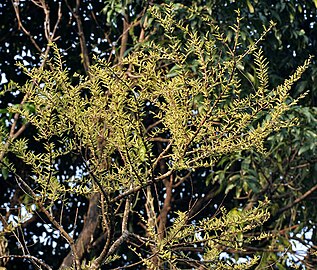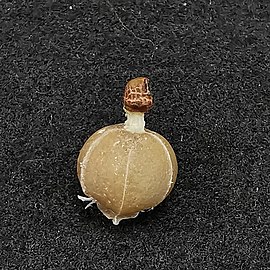Phyllanthus emblica
| Phyllanthus emblica | |
|---|---|

| |
| Plant | |

| |
| Fruit, whole and halved | |
| Scientific classification | |
| Kingdom: | Plantae |
| Clade: | Tracheophytes |
| Clade: | Angiosperms |
| Clade: | Eudicots |
| Clade: | Rosids |
| Order: | Malpighiales |
| Family: | Phyllanthaceae |
| Genus: | Phyllanthus |
| Species: | P. emblica
|
| Binomial name | |
| Phyllanthus emblica | |
| Synonyms[3][4] | |
| |
Phyllanthus emblica, also known as emblic,[2][5] emblic myrobalan,[2] myrobalan,[5] Indian gooseberry,[2][5] Malacca tree,[5] amloki or amla,[5] is a deciduous tree of the family Phyllanthaceae. Its native range is tropical and southern Asia.[4]
Description
[edit]The tree is small to medium in size, reaching 1–8 metres (3+1⁄2–26 feet) in height. The bark is mottled. The branchlets are finely pubescent (not glabrous), 10–20 centimetres (4–8 inches) long, usually deciduous. The leaves are simple, subsessile and closely set along branchlets, light green, resembling pinnate leaves. The flowers are greenish–yellow. The fruit is nearly spherical, light greenish–yellow, quite smooth and hard on appearance, with six vertical stripes or furrows. The fruit is up to 26 millimetres (1 in) in diameter, and, while the fruit of wild plants weigh approximately 5.5 grams (0.2 ounces), cultivated fruits average 28.4 g (1 oz) to 56 g (2 oz).[6]
Chemical constituents
[edit]The fruits contain high amounts of ascorbic acid (vitamin C),[7] and have a bitter taste that may derive from a high density of ellagitannins,[8] such as emblicanin A (37%), emblicanin B (33%), punigluconin (12%), and pedunculagin (14%).[9] Amla also contains punicafolin and phyllanemblinin A, phyllanemblin other polyphenols, such as flavonoids, kaempferol, ellagic acid, and gallic acid.[8][10]
Uses
[edit]Ripening in autumn, the berries are harvested by hand after climbing to upper branches bearing the fruits. The taste of Indian emblic is sour, bitter and astringent, and it is quite fibrous.
Culinary
[edit]The amla fruit may be eaten raw or cooked, and in South Asia, the fruit is often pickled with salt, oil, and spices. It is used as an ingredient in dishes including dal (a lentil preparation), and is also made into amle ka murabbah, a sweet dish made by soaking the berries in sugar syrup until they are candied. It is traditionally consumed after meals.[citation needed]
In the Batak area of Sumatra, Indonesia, the inner bark is used to impart an astringent, bitter taste to the broth of a traditional fish soup known as holat.[11]
Traditional medicine
[edit]In Ayurveda, dried and fresh fruits of the plant are used as a common constituent.[8][12]
In culture
[edit]In the Buddhist tradition there are many references to the fruit of the emblic myrobalan. In the Śatapañcāśatka, Buddha's knowledge is described in a poetic simile: "O Bhagavan, the entire origination of all types of phenomena throughout time is within the range of your mind, like an ambalan fruit in the palm of your hand".[13]
Half an amla fruit was the final gift to the Buddhist sangha by the great Indian emperor Ashoka. This is illustrated in the Ashokavadana in the following verses: "A great donor, the lord of men, the eminent Maurya Ashoka, has gone from being lord of Jambudvipa [the continent] to being lord of half a myrobalan".[14] In Theravada Buddhism, this plant is said to have been used as the tree for achieving enlightenment, or Bodhi, by the twenty-first Buddha, named Phussa Buddha.[15]
In Hinduism, the myrobalan, called the āmalaka in Sanskrit, is sacred to all three members of the Trimurti, the Hindu supreme trinity of Brahma, Vishnu, and Shiva. According to legend, during a religious gathering, Lakshmi, Vishnu's consort, expressed a desire to worship Shiva, while Parvati, Shiva's consort, wished to worship Vishnu. Moved by each other's piety, they shed tears upon the earth, from which emerged the first myrobalan trees.[16] The Amalaka Ekadashi is a Hindu occasion dedicated to Vishnu, venerating the myrobalan.
-
Hand of a standing Buddha statue holding a myrobalan
-
Amala in Bhopal Madhya Pradesh
See also
[edit]- Emblicanin
- Triphala, an Ayurvedic mixture containing amla.
References
[edit]- ^ Roland, C. (2020). "Phyllanthus emblica". IUCN Red List of Threatened Species. 2020: e.T149444430A149548926. doi:10.2305/IUCN.UK.2020-3.RLTS.T149444430A149548926.en. Retrieved 19 November 2021.
- ^ a b c d "Phyllanthus emblica". Germplasm Resources Information Network. Agricultural Research Service, United States Department of Agriculture. Retrieved 2008-03-06.
- ^ "Phyllanthus emblica L." World Flora Online. World Flora Consortium. 2023. Archived from the original on 20 May 2023. Retrieved 25 April 2023.
- ^ a b "Phyllanthus emblica L." Plants of the World Online. Royal Botanical Gardens, Kew. Archived from the original on 1 June 2022. Retrieved 30 June 2022.
- ^ a b c d e Lim, T.K. (2012). "Phyllanthus emblica". Edible Medicinal And Non-Medicinal Plants. Springer Netherlands. pp. 258–296. doi:10.1007/978-94-007-4053-2_37. ISBN 9789400740525.
- ^ Huxley. A. The New RHS Dictionary of Gardening. 1992. MacMillan Press 1992 ISBN 0-333-47494-5
- ^ Tarwadi K, Agte V (Aug 2007). "Antioxidant and micronutrient potential of common fruits available in the Indian subcontinent". Int J Food Sci Nutr. 58 (5): 341–9. doi:10.1080/09637480701243905. PMID 17558726. S2CID 7663752.
- ^ a b c Dharmananda S (September 2003). "Emblic myrobalans (Amla)". Institute of Traditional Medicine. Archived from the original on 2005-09-01. Retrieved 2006-02-07.
- ^ Bhattacharya, A.; Chatterjee, A.; Ghosal, S.; Bhattacharya, S. K. (1999). "Antioxidant activity of active tannoid principles of Emblica officinalis (amla)". Indian Journal of Experimental Biology. 37 (7): 676–680. PMID 10522157.
- ^ Habib-ur-Rehman; Yasin KA; Choudhary MA; et al. (Jul 2007). "Studies on the chemical constituents of Phyllanthus emblica". Nat. Prod. Res. 21 (9): 775–81. doi:10.1080/14786410601124664. PMID 17763100. S2CID 30716746.
- ^ de Clercq, F. S. A. (1909). Nieuw Plantkundig Woordenboek voor Nederlandsch Indië. Amsterdam: J. H. de Bussy. p. 303.
- ^ Indian Ministry of Health and Family Planning. The Ayurvedic Formulary of India. Part I. 1st ed. Delhi, 1978.
- ^ Chen, K. (1952). The Śatapañcāśatka of Mātrceta: Sanskrit Text, Tibetan translation and commentary, and Chinese translation. Edited by D. R. Shackleton Bailey, with an introduction, English translation and notes. Cambridge: The University Press, 1951. xi, 237 p. The Far Eastern Quarterly, 11(3), 408–410. doi:10.2307/2049590.
- ^ Strong, J. S. (1983) The Legend of King Ashoka. New York: Princeton University Press. p. 99.
- ^ Buddha: His Life, His Teachings, His Order: Together with the History of the Buddhism, Manmatha Nath Dutt, Society for the resuscitation of Indian literature, 1901, p. 3
- ^ Elgood, Heather (2000-04-01). Hinduism and the Religious Arts. A&C Black. p. 114. ISBN 978-0-304-70739-3.
External links
[edit] Media related to Phyllanthus emblica at Wikimedia Commons
Media related to Phyllanthus emblica at Wikimedia Commons













